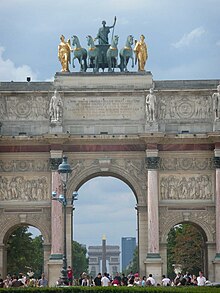Axe historique
48°52′14.20129″N2°18′18.12787″E/ 48.8706114694°N 2.3050355194°E
This articleneeds additional citations forverification.(February 2024) |

TheAxe historique(French:[aksistɔʁik];"historical axis" ) refers to a straightly aligned series of thoroughfare streets, squares, monuments and buildings that extend from the centre ofParis,France,to the west-northwest of the city. It is also known as theVoie Triomphale(French:[vwatʁijɔ̃fal];"triumphal way" ).[1]
TheAxe historiquebegan with the creation of theChamps-Élysées,designed in the 17th century to create a vista to the west, extending the central axis of the gardens to the royalTuileries Palace.Today theTuileries Garden(Jardin des Tuileries) remain, preserving their wide central pathway, though the palace was burned down during theParis Commune,1871.[2]
Between the Tuileries Garden and the Champs-Élysées extension a jumble of buildings remained on the site ofPlace de la Concordeuntil early in the reign ofLouis XV,for whom the square was at first named. Then the garden axis could open through a grand gateway into the new royal square.
To the east, the Tuileries Palace faced an open square, thePlace du Carrousel.There, by order of Napoleon, theArc de Triomphe du Carrouselwas centered on the palace (and so on the same axial line that was developing beyond the palace). Long-standing plans to link theLouvre Palace,as the disused palace was called, with the Tuileries, by sweeping away the intervening buildings, finally came to fruition in the early 19th century. Consequently, the older axis extending from the courtyard of the Louvre is slightly skewed to the rest of what has become theAxe historique,but theArc du Carrousel,at the fulcrum between the two, serves to disguise the discontinuity.
To the west, the completion of theArc de Triomphein 1836 on thePlace de l'Étoileat the western end of the Champs-Élysées formed the far point of this line of perspective, which now starts at the equestrian statue ofLouis XIVplaced byI.M. Peiadjacent to hisLouvre Pyramidin the Cour Napoléon of theLouvre.
The axis was extended again westwards along theAvenue de la Grande Armée,past the city boundary of Paris toLa Défense.This was originally a large junction, named for a statue commemorating the defence of Paris in theFranco-Prussian War.
In the 1950s, the area around La Défense was marked out to become a new business district, and high-rise office buildings were built along the avenue. The axis found itself extended yet again, with ambitious projects for the western extremity of the modern plaza.
It was not until the 1980s, under presidentFrançois Mitterrand,that a project was initiated, with a modern 20th century version of the Arc de Triomphe. This is the work ofDanisharchitectJohan Otto von Spreckelsen,La Grande Arche de la Fraternité (also known as simply LaGrande Archeor L'Arche de la Défense), a monument to humanity and humanitarian ideals rather than militaristic victories. It was inaugurated in 1989.[2][1]
The network of railway lines and road tunnels beneath the elevated plaza of La Défense prevented the pillars supporting the arch from being exactly in line with the axis: it is slightly out of line, bending the axis should it be extended further to the west. From the roof of the Grande Arche, a second axis can be seen: theTour Montparnassestands exactly behind theEiffel Tower. TheSeine-Archeproject is extending the historical axis to the West through the city ofNanterre,but with a slight curve.
Solar alignment
[edit]As a natural consequence of the nature of the line, the sun sets behind the Grande Arche twice per year, in a phenomenon dubbed "Parishenge".
Gallery
[edit]-
TheAxe historiquelooking west from thePlace de la Concorde.
-
TheAxe historiqueseen from theTuileries Garden.
-
The Grande Arche seen from the Arc de Triomphe on theAxe historique.
-
View from the Tuileries towards the Arc de Triomphe.
-
The Arc de Triomphe from La Défense 5 km (3 mi) away, showing how precisely the axis is aligned.
-
From the roof of the Grande Arche, past the skyscrapers of La Défense, down theAxe historique.
See also
[edit]- The North-South Central Axis of Beijing City– a similar axis inBeijing.
External links
[edit]- Entryon greatbuildings.com
References
[edit]- ^abPorter, Tom (2 August 2004).Archispeak: An Illustrated Guide to Architectural Terms.Routledge.ISBN978-1-134-42165-7.
- ^abKelley, Russell (1 March 2021).The Making of Paris: The Story of How Paris Evolved from a Fishing Village into the World's Most Beautiful City.Rowman & Littlefield.ISBN978-1-4930-5054-3.







